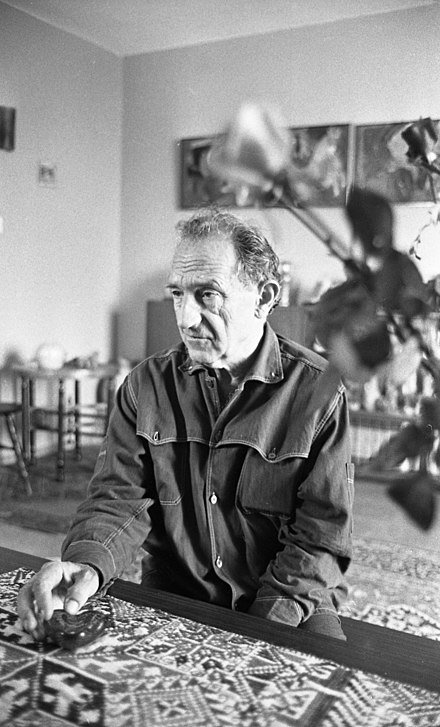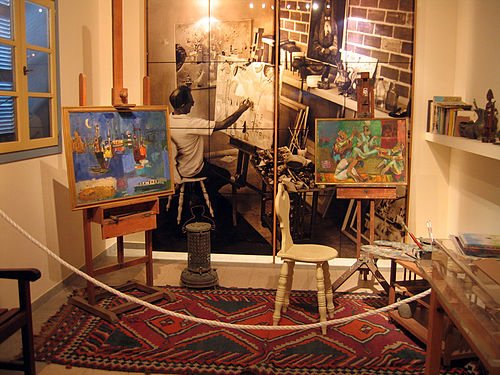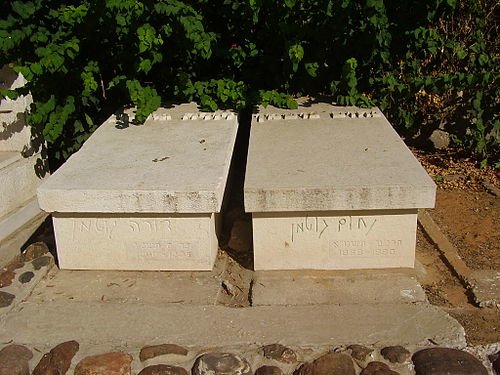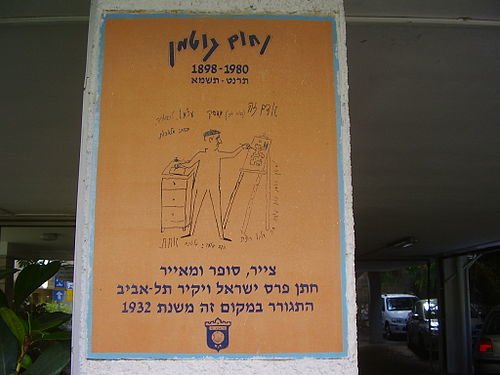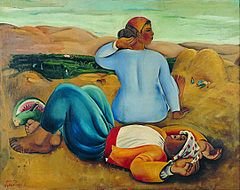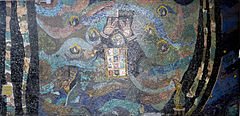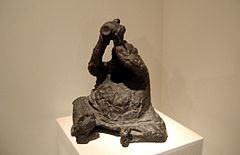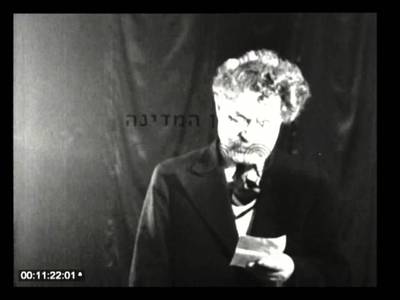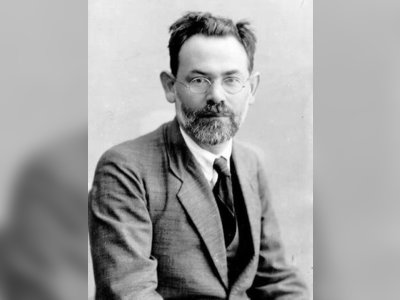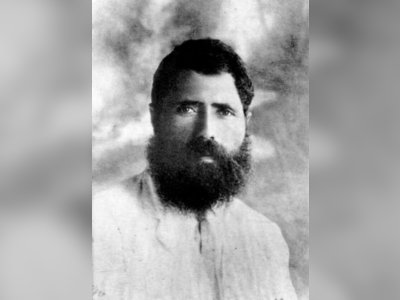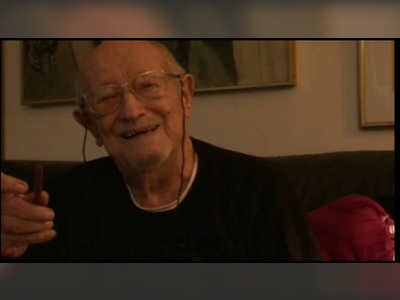מורשת גדולי האומה
בזכותם קיים
beta
Nahum Gutman: An Artistic Journey through the 20th Century
Nahum Gutman, a prolific Israeli artist, illustrator, sculptor, and writer, left an indelible mark on the cultural landscape of Israel in the 20th century. Born on October 15, 1898, in Telenesti, Serbia (then part of the Russian Empire, now Moldova), Gutman's life and work spanned continents and epochs. He passed away on November 28, 1980, in Tel Aviv, leaving a rich legacy of artistic contributions, particularly in the realm of children's literature.
Childhood and Adolescence (1898-1913)
Nahum Gutman was the fourth of five children born to Shmuel Ben-Zion (alter ego Gutman) and his wife Rivka. In 1903, the Gutman family relocated to Odessa, where Nahum began his Hebrew studies in the "Cheder HaMitukan," an educational initiative established by his father, a renowned writer.
In 1905, the Gutman family made their way to the land of Israel, settling initially in Neve Shalom, a neighborhood on the outskirts of Jaffa. Young Nahum spent five years studying at the "Bet HaSefer LeBanot" in Neve Tzedek, where his father served as a teacher, and the family resided in the same building. Subsequently, he continued his education at the "Ezra" school. The Gutman household in Neve Tzedek became a cultural hub frequented by notable literary figures such as Y. H. Brenner, S. Y. Agnon, Yehuda Burla, Azar, and others.
In 1910, Nahum Gutman lost his mother in Tiberias, and she was interred by Sh. Y. Agnon, who was working as his father's secretary at the time. This event left a lasting impression on Gutman, who refrained from painting his mother's portrait, unlike his other family members.
The Gutman family later moved to a residence on Buzaglo Street in Neve Tzedek. Nahum Gutman began his studies at the Herzliya Gymnasium, conveniently located adjacent to their home on Herzl Street #3. Concurrently, he commenced his art lessons with the painter Ira Jan.
From Bezalel to Europe (1913-1926)
At the age of 16, Gutman pursued his artistic education at the Bezalel Academy under the guidance of Abel Pann and Zeev Raban. However, at the age of 18, he returned to Tel Aviv to protect the empty city, as many residents had been expelled. At the end of World War I, he volunteered with a majority of Bezalel students to join the Jewish Legion.
Between 1920 and 1926, Gutman continued his artistic studies in Vienna, Berlin, and Paris. During this period, he created numerous prints, including "Job and His Friends." In 1923, he illustrated his father's book, "Letters to Young People," published in Berlin, as well as the children's book "Ha-Chalil" by Shaul Tchernichovsky. This marked the beginning of his extensive career as an illustrator of Hebrew children's books. Gutman also developed a close friendship with Frieda Peltz, a young Jewish anthropologist who had immigrated from the United States to Europe. However, their romantic relationship ended when Gutman returned to Tel Aviv in the spring of 1925.
The Land of Israel
Upon his return to the Land of Israel in 1926, Gutman held art exhibitions and participated in exhibitions of the Land of Israel artists at the David's Tower. He was a member of the "Eretz Yisrael School" along with Israel Paldi, Reuven Rubin, and Ziona Tagger. Their artistic themes were centered on the landscapes, people, and colors of the Land of Israel, emphasizing the vivid and radiant aspects of the land. They drew inspiration from the Arab inhabitants of the region, believing that their appearance was closest to that of the ancient Hebrews in biblical times.
Gutman extended his artistic talents to children's books, illustrating works by prominent authors such as Hayim Nahman Bialik, as well as numerous biblical stories and textbooks. Over the years, he illustrated hundreds of books, including his own works. In addition to his work as a painter and writer, Gutman designed the first emblem for the city of Tel Aviv and was involved in theater set design.
In 1928, he married Dora Yaffe, the sister of Katrile Yaffe, the chief officer of the ship "23 Yordei HaSira." In 1936, they welcomed their son Menachem (Chemi).
"Davar L'Yeladim"
In 1931, Gutman played a pivotal role in founding the children's magazine "Davar L'Yeladim" (Words for Children), becoming its permanent illustrator for 32 years. He created cover art, illustrated countless stories and poems, and contributed his own writings and illustrations, which were later compiled into books.
In 1934, at the request of the Tel Aviv municipality, Gutman was sent to South Africa to create a portrait of Jan Smuts. The editor of "Davar L'Yeladim," Yitzhak Yatziv, suggested documenting his journey with an illustrated travelogue since Gutman could not paint materials he hadn't seen with his own eyes. This travelogue, combining fact and fiction, was published serially in the magazine and later collected in his first book, "In the Land of Lobengula, King of the Zulus."
Documenting the Early Tel Aviv
During the War of Independence, Gutman served as a military artist, and his drawings were published in the booklet "The Animals of the Negev."
An essential aspect of Gutman's work over the years was the documentation and preservation of the early history of Tel Aviv. His father, Sh. Ben Zion, was one of the 66 founders of the city, and Gutman's paintings, created decades later, brought to life the appearance, events, people, and houses of the nascent city. In celebration of Tel Aviv's jubilee, Nahum Gutman gathered his memories and artwork from the early days of Neve Tzedek and published the book "A Small City with Few People: Stories of the Beginning of Beit House, Which Is Tel Aviv." This book provides a rare and invaluable source of information for those studying this period.
In the 1950s, Gutman gained international recognition, with his paintings displayed in prestigious museums worldwide. He represented Israel at international biennials and was honored with the Hans Christian Andersen Award for Children's Literature for his book "The Path of the Orange Peels." He was also named an Honorary Citizen of Tel Aviv-Jaffa in 1976 and received the Israel Prize for Children's Literature in 1978.
In 1966, he created a large fresco depicting life in Tel Aviv, displayed in the western entrance hall of Shalom Tower. In 1976, Gutman designed another fresco titled "The History of Tel Aviv," featuring the city's history on three large panels and 15 additional pictures. While initially placed on the façade of the old Tel Aviv City Hall on Bialik Square, it was later relocated and currently stands on the front of Rothschild Tower 1.
Nahum Gutman passed away on November 28, 1980, in Tel Aviv, and he was buried in the old cemetery on Trumpeldor Street in the city. In 1998, the Nahum Gutman Museum of Art was established in Neve Tzedek, Tel Aviv, where his original works in oil, watercolor, and drawing are displayed.
In 1971, filmmaker Yona Zaretzky produced a documentary about Nahum Gutman and his art.
In 2007, an animated feature film based on Gutman's life and artwork, titled "Between the Sand and the Sky," was released in theaters. The screenplay was written by Diti Grovi, inspired by Gutman's stories and illustrations.
Nahum Gutman's legacy endures, not only through his art but also as a chronicler of Tel Aviv's early days and a beloved figure in the annals of Israeli culture.
Nahum Gutman was the fourth of five children born to Shmuel Ben-Zion (alter ego Gutman) and his wife Rivka. In 1903, the Gutman family relocated to Odessa, where Nahum began his Hebrew studies in the "Cheder HaMitukan," an educational initiative established by his father, a renowned writer.
In 1905, the Gutman family made their way to the land of Israel, settling initially in Neve Shalom, a neighborhood on the outskirts of Jaffa. Young Nahum spent five years studying at the "Bet HaSefer LeBanot" in Neve Tzedek, where his father served as a teacher, and the family resided in the same building. Subsequently, he continued his education at the "Ezra" school. The Gutman household in Neve Tzedek became a cultural hub frequented by notable literary figures such as Y. H. Brenner, S. Y. Agnon, Yehuda Burla, Azar, and others.
In 1910, Nahum Gutman lost his mother in Tiberias, and she was interred by Sh. Y. Agnon, who was working as his father's secretary at the time. This event left a lasting impression on Gutman, who refrained from painting his mother's portrait, unlike his other family members.
The Gutman family later moved to a residence on Buzaglo Street in Neve Tzedek. Nahum Gutman began his studies at the Herzliya Gymnasium, conveniently located adjacent to their home on Herzl Street #3. Concurrently, he commenced his art lessons with the painter Ira Jan.
From Bezalel to Europe (1913-1926)
At the age of 16, Gutman pursued his artistic education at the Bezalel Academy under the guidance of Abel Pann and Zeev Raban. However, at the age of 18, he returned to Tel Aviv to protect the empty city, as many residents had been expelled. At the end of World War I, he volunteered with a majority of Bezalel students to join the Jewish Legion.
Between 1920 and 1926, Gutman continued his artistic studies in Vienna, Berlin, and Paris. During this period, he created numerous prints, including "Job and His Friends." In 1923, he illustrated his father's book, "Letters to Young People," published in Berlin, as well as the children's book "Ha-Chalil" by Shaul Tchernichovsky. This marked the beginning of his extensive career as an illustrator of Hebrew children's books. Gutman also developed a close friendship with Frieda Peltz, a young Jewish anthropologist who had immigrated from the United States to Europe. However, their romantic relationship ended when Gutman returned to Tel Aviv in the spring of 1925.
The Land of Israel
Upon his return to the Land of Israel in 1926, Gutman held art exhibitions and participated in exhibitions of the Land of Israel artists at the David's Tower. He was a member of the "Eretz Yisrael School" along with Israel Paldi, Reuven Rubin, and Ziona Tagger. Their artistic themes were centered on the landscapes, people, and colors of the Land of Israel, emphasizing the vivid and radiant aspects of the land. They drew inspiration from the Arab inhabitants of the region, believing that their appearance was closest to that of the ancient Hebrews in biblical times.
Gutman extended his artistic talents to children's books, illustrating works by prominent authors such as Hayim Nahman Bialik, as well as numerous biblical stories and textbooks. Over the years, he illustrated hundreds of books, including his own works. In addition to his work as a painter and writer, Gutman designed the first emblem for the city of Tel Aviv and was involved in theater set design.
In 1928, he married Dora Yaffe, the sister of Katrile Yaffe, the chief officer of the ship "23 Yordei HaSira." In 1936, they welcomed their son Menachem (Chemi).
"Davar L'Yeladim"
In 1931, Gutman played a pivotal role in founding the children's magazine "Davar L'Yeladim" (Words for Children), becoming its permanent illustrator for 32 years. He created cover art, illustrated countless stories and poems, and contributed his own writings and illustrations, which were later compiled into books.
In 1934, at the request of the Tel Aviv municipality, Gutman was sent to South Africa to create a portrait of Jan Smuts. The editor of "Davar L'Yeladim," Yitzhak Yatziv, suggested documenting his journey with an illustrated travelogue since Gutman could not paint materials he hadn't seen with his own eyes. This travelogue, combining fact and fiction, was published serially in the magazine and later collected in his first book, "In the Land of Lobengula, King of the Zulus."
Documenting the Early Tel Aviv
During the War of Independence, Gutman served as a military artist, and his drawings were published in the booklet "The Animals of the Negev."
An essential aspect of Gutman's work over the years was the documentation and preservation of the early history of Tel Aviv. His father, Sh. Ben Zion, was one of the 66 founders of the city, and Gutman's paintings, created decades later, brought to life the appearance, events, people, and houses of the nascent city. In celebration of Tel Aviv's jubilee, Nahum Gutman gathered his memories and artwork from the early days of Neve Tzedek and published the book "A Small City with Few People: Stories of the Beginning of Beit House, Which Is Tel Aviv." This book provides a rare and invaluable source of information for those studying this period.
In the 1950s, Gutman gained international recognition, with his paintings displayed in prestigious museums worldwide. He represented Israel at international biennials and was honored with the Hans Christian Andersen Award for Children's Literature for his book "The Path of the Orange Peels." He was also named an Honorary Citizen of Tel Aviv-Jaffa in 1976 and received the Israel Prize for Children's Literature in 1978.
In 1966, he created a large fresco depicting life in Tel Aviv, displayed in the western entrance hall of Shalom Tower. In 1976, Gutman designed another fresco titled "The History of Tel Aviv," featuring the city's history on three large panels and 15 additional pictures. While initially placed on the façade of the old Tel Aviv City Hall on Bialik Square, it was later relocated and currently stands on the front of Rothschild Tower 1.
Nahum Gutman passed away on November 28, 1980, in Tel Aviv, and he was buried in the old cemetery on Trumpeldor Street in the city. In 1998, the Nahum Gutman Museum of Art was established in Neve Tzedek, Tel Aviv, where his original works in oil, watercolor, and drawing are displayed.
In 1971, filmmaker Yona Zaretzky produced a documentary about Nahum Gutman and his art.
In 2007, an animated feature film based on Gutman's life and artwork, titled "Between the Sand and the Sky," was released in theaters. The screenplay was written by Diti Grovi, inspired by Gutman's stories and illustrations.
Nahum Gutman's legacy endures, not only through his art but also as a chronicler of Tel Aviv's early days and a beloved figure in the annals of Israeli culture.
- נחום גוטמןhe.wikipedia.org
